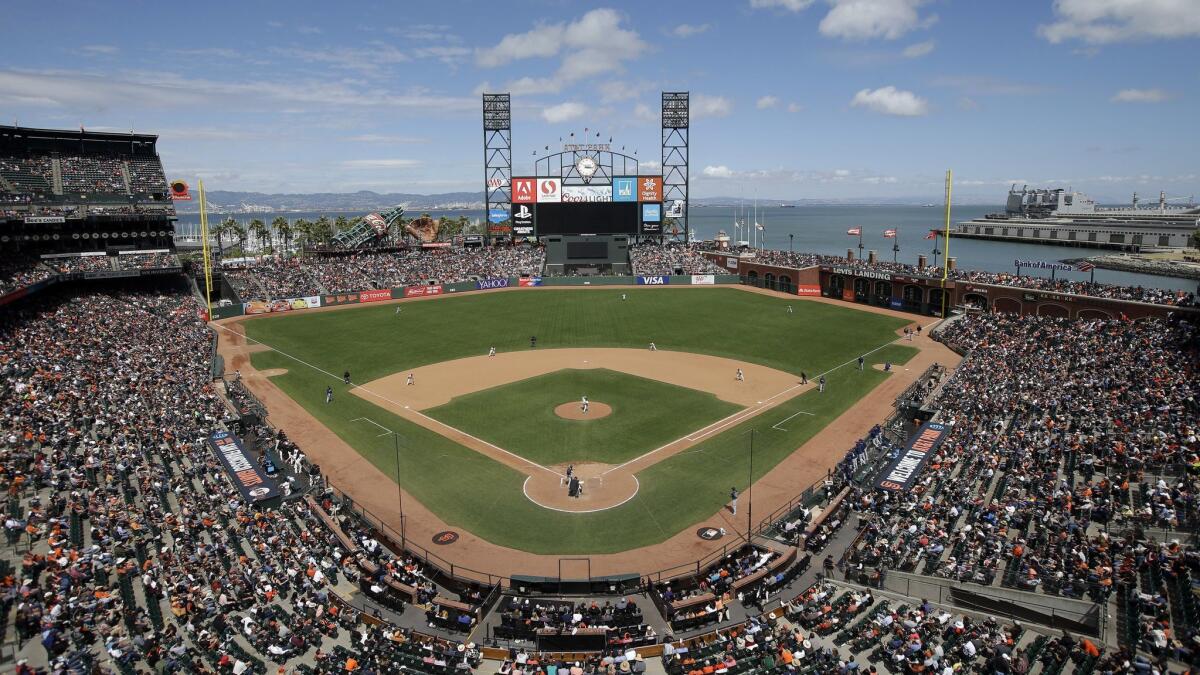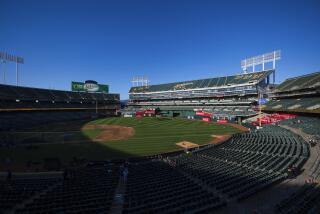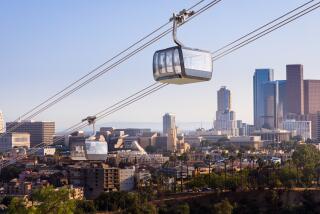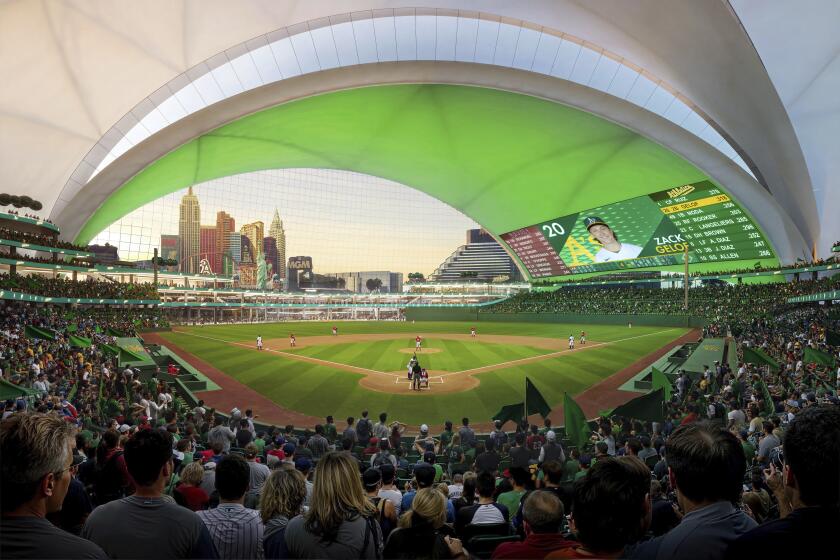Oakland’s Athletics need a home. They may get one — and provide 6,000 more
The Oakland Athletics badly need a new home. Their current one, plagued by plumbing problems, is an uncomfortable throwback to the days when baseball and football teams shared generic stadiums lacking in charm and good sight lines.
For two decades, the baseball team has looked for that new ballpark throughout the Bay Area. The Athletics’ latest offer, and possibly their last, is to build 6,001 homes in Oakland — one for themselves along the waterfront, the rest for a city desperately in need of housing.
In times past, taxpayers typically financed the stadiums and arenas, and the teams kept the profits. As California led the way in cutting those subsidies, owners turned to real estate development, making money by surrounding their venues with restaurants, shops and offices.
Now, with soaring rents in Oakland and elsewhere amplifying the housing shortage in California’s coastal cities, they are building homes.
The Athletics, San Francisco Giants and Rams have proposed to build a combined 10,000 housing units over the next 13 years. The balance between homes leased at market rate and those leased at so-called affordable rates — reserved for lower-income residents — could help determine the legacy of those teams beyond wins and losses.
Everyone Home, an organization working to end homelessness in Alameda County, counted 2,761 homeless persons in Oakland in a 2017 study, a number that is expected to rise as the study is repeated this year. Cat Brooks, an Oakland activist and the runner-up in last November’s mayoral election, said the Athletics can be part of the solution.
“When we are in times of crisis, it’s everybody’s job” to help, Brooks said. “If you’re going to make millions and millions of dollars from being here, you have an obligation to give back. And right now, that’s the community need. … This is a way for them to show up in the community that can really make a difference.”
Across the bay, the Giants already enjoy a picturesque waterfront ballpark — formerly AT&T Park, now Oracle Park. They escaped a decrepit stadium uncomfortably shared with a football team, but not easily.

The Giants went to the ballot four times within a decade, asking for taxpayer money to build a new ballpark. They went zero for four.
If owners control surrounding development, they can generate revenue to help pay for new venues, and for star players too, while still turning a profit. AEG, owner of the Kings, did it with Staples Center and L.A. Live. Anaheim has pitched Angels owner Arte Moreno the concept of funding a new or renovated Angel Stadium by letting him put up eateries, hotels and offices in the stadium parking lot.
Traffic congestion and housing shortages in California’s major cities have led commercial developers to add homes to their projects, so that residents can walk to work and play where they live. “That’s where the demand is,” Giants president Larry Baer said during an interview last month.
The Giants paid for their own ballpark. They now are building 1,500 homes within their Mission Rock neighborhood, across McCovey Cove from the ballpark, with shops, offices, and parkland included in the project, targeted for completion in 2025.
Baer said the goodwill the Giants have developed in 60 years in San Francisco can help residents trust the team as a developer.
“We have a lot of skin in the game,” he added.
Oakland Mayor Libby Schaaf was born and raised in her city. “In our house, we never had blueberry muffins. We had Vida Blue-berry muffins,” she said, the reference a nod to the Oakland pitcher voted most valuable player in the American League in 1971.
Yet Schaaf did not endorse a 2017 plan for the construction of a downtown ballpark, even though the NBA’s Golden State Warriors and NFL’s Raiders were on their way out — the Warriors to San Francisco, the Raiders to Las Vegas. The Athletics were willing to stay, and were offering to pay for a new stadium rather than demand the city foot the bill. But the mayor worried that the downtown ballpark might disrupt a neighborhood and displace residents.
That plan collapsed when the college district that owned the would-be ballpark land opted not to sell it.
Schaaf supports the Athletics’ latest proposal for a ballpark near Jack London Square, along the estuary that separates Oakland from the island city of Alameda. The site, located next to a company that recycles scrap metal, currently is used for shipping containers and truck parking.
“This really stands to revitalize a part of the city that has been in this kind of vague transition between the old industrial waterfront and the new public amenity waterfront,” Schaaf said.
If the Athletics move, they want to retain control of the Oakland Coliseum site they would be leaving. The Warriors and Raiders would be gone by then. Left behind would be two abandoned sports venues — surrounded by parking lots, bordered by a busy freeway on one side and railroad tracks on the other — in a neglected industrial part of town.
“You have to have something there to build that area,” said Athletics shortstop Marcus Semien, who lives in Oakland and attended high school and college in nearby Berkeley. “There’s not a lot of business around there. There’s not a lot of desire to go there right now.”
The Athletics want to be the developer. The team worked with community groups to prepare a plan that would include a park, youth sports facilities, an events center, shops, restaurants, offices and a technology campus.
And homes.
The Athletics propose to build 3,000 residences near the new ballpark and another 3,000 on the Coliseum site. In all, Athletics president Dave Kaval said, the plans could provide housing for 20,000 people.
Delivering the waterfront project would be a particular challenge. In 2013, former Athletics managing partner Lew Wolff told the San Francisco Chronicle that putting a ballpark there would be “as close to impossible as anything.”
The land, long used for industrial purposes, would need to be cleansed of chemicals and pollutants. The ballpark would be cut off from the rest of Oakland on one side by San Francisco Bay, on another side by a freeway and railroad tracks, although Kaval has proposed expanded ferry service on the bay and a gondola over the freeway.
Kaval said the Athletics could build their new ballpark even without securing the rights to redevelop the Coliseum site.
“We felt that, if we didn’t advance a plan for that, we wouldn’t be fulfilling our responsibility to Oakland,” Kaval said. “It’s up to the city fathers and mothers to decide whether they want to accept our offer. Maybe, in the end, they want to do something different.”
Said Schaaf: “The two projects must stand on their own.”
She added that it would be premature to commit to an open bidding process for the Coliseum land, to see whether a development company might offer a higher price than the Athletics, or propose to build more homes. Kaval said the Athletics already are proposing the maximum amount of housing under city rules governing development of the area.
The land is owned jointly by the city and Alameda County. Those entities conducted a confidential appraisal of the Coliseum site in 2016, said Justin Berton, Schaaf’s director of communications. The city has not commissioned an appraisal of the Coliseum site since then, he said.
Kaval said the Athletics have raised their offer for the site from $137 million to $160 million, in line with what the team believes is fair market value. Similar properties along the adjacent freeway have sold for $40 to $50 per square foot, said Sam Swan, an Oakland-based managing director of JLL, a real estate and investment management firm.
At that rate, market value for the 120-acre Coliseum site would be $209 million to $261 million, but Swan cautioned that “the density of the final development plan will be the major determining factor in the ultimate value.”
Said Schaaf: “Typically, I believe in competition. But the A’s are not a profit-driven real estate development corporation. They are a civic asset. They are a longstanding member of our community that recognizes their value is not only measured in dollars but in civic pride.
Sign up for our daily sports newsletter »
“To me, that gives them a presumption of being the type of partner — and they’re looking for a development partnership — that will have the community’s interests at heart.”
If the Athletics don’t get a stadium on the waterfront, Kaval repeatedly declined to say whether team owner John Fisher would build at the Coliseum site or sell the team — perhaps to buyers that would move it out of the Bay Area.
“We’re focused on success at the waterfront,” Kaval said.
Schaaf is focused on affordable housing, and the considerable help the Athletics might be able to lend. The Oakland housing crisis is about a city pricing out teachers, public safety workers and longtime renters, not about an absence of construction.
“We are having the biggest building boom that we believe we’ve had since the 1906 earthquake,” she said. “What I am really going to be focusing on is how much of that housing is affordable.”
An entry level teacher in Oakland would have to pay 72% of their salary toward a one-bedroom apartment in the city, and a minimum-wage worker could not afford a one-bedroom apartment even if every dollar of her salary went to the rent, according to a PolicyLink study in 2016.
In the Giants’ Mission Rock project — negotiated with the city of San Francisco and approved by voters there — 40% of the residences are reserved for affordable housing.
If the Athletics were to match that percentage, they would build 2,400 affordable homes. Schaaf has set a citywide goal of 2,900 affordable homes over the next eight years.
“I think time will tell whether having your sports team as a real estate developer is good or bad,” she said. “What makes me optimistic is that a team is not judged just by its monetary profits. It is judged by its contributions to its community.
“Sports teams, arguably, have been in the community-building business for a long time, as far as civic pride. Let’s give them a shot at building community assets that go beyond the team and the pride that they give their communities.”
More to Read
Get our high school sports newsletter
Prep Rally is devoted to the SoCal high school sports experience, bringing you scores, stories and a behind-the-scenes look at what makes prep sports so popular.
You may occasionally receive promotional content from the Los Angeles Times.







